Vielha
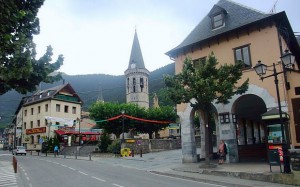
Vielha is the capital of the Aran Valley and constitutes the urban centre of Vielha e Mijaran, made up of 13 towns. In this municipality we find a wide range of tourism and administrative services, in addition to a historic quarter worth exploring.
The original urban centre runs along the Nere River, and it is here where old civil buildings are preserved, such as the Fortified Tower of Santesmasses, housing the Museu Etnologic dera Aran Valley.
There is a wide range of activities for those of all tastes and ages, such as hiking, horseback riding, 4X4s, cycling, fishing, adventure sports, etc. Among the outstanding sports venues in Vielha, we recommend the Palai de Gèu, a sports/recreational complex with a heated swimming pool, ice skating rink, and gym.
The parish church of Sant Miquèu, located in the centre of the municipality, is its most representative. Built in different periods, the oldest part dates from the 12th century, and the most recent, from the 18th. Its 12th-century facade features 59 carved figures; the belfry is an octagonal tower from the 16th century; the baptismal font is Romanesque, and the piece on the High Altar dates from the 15th. But the most interesting element is the Cris de Mijaran: a 12th-century carving and the only existing piece of an ancient Descent from the Cross, probably destroyed in the 15th century.
Escunhau
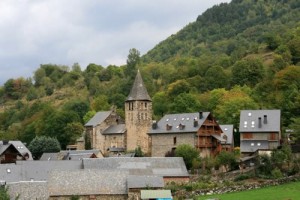
Escunhau sits at an elevation of 1,049 m, on the slopes of the Pic del Mitgdia. Its parish church dedicated to Sant Pere is a highlight, a Romanesque construction dating from the 12th century. Inside we find a single nave with a two-arch portal featuring an anagram of Christ, carved columns and capitals, and Gothic windows. The bell tower also features a square design.
Baqueira Beret
The town of Baqueira is the site of one of Spain's premier winter resorts: Baqueira Beret, declared a Centre of National Tourist Interest. The resort offers every amenity for active tourism enthusiasts, in both the winter and summer. The facility offers more than 150 km of runs, satisfying avid skiers year after year.
And, in the summertime, Baqueira is the perfect place for hiking and mountain biking.
Bausen
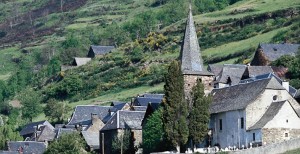
The village of Bausen is one of the most idyllic villages in the Baish Aran(nature reserve), bordering on France. The town, sitting at an elevation of 945 m, is located on the face of the Vacanera mountain rangeextending on the left bank of the Garonne River. This town has maintained its rustic authenticity by avoiding the impact of new construction projects.
In this municipality we find the church of Sant Pèir ad Vincula, a modern era building from the 18th century, as indicated by the lintel on its door, dating from 1709. Its main facade features a fragment of a Roman cinerary stela in dark marble, with three busts under horseshoe arches, adorned with astral symbols. In Bausen we find one of the most historic and poignant stories in the Aran Valley, that of the town's famous lovers, and excursions to the beautiful Carlac Forest.
Aubert
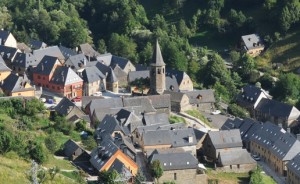
The village of Aubert stands at an elevation of 912 m, and is divided by the national road, which runs through it. This village, with small streets winding around its church, the Iglesia del Roser, dating from 12th and 13th centuries, is the perfect place to undertake some of most famous excursions in the Aran Valley: the Bosque (forest) de Baricauba, and its ascent to the Bassa d'Oles(lake). Aubert also has an old Romanesque church dedicated to Sant Martí, which once served as a convent for the monks of San Agustín.
Arties
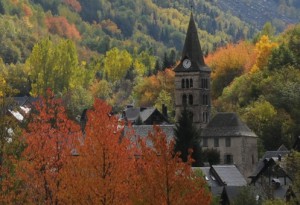
Arties is the perfect place to appreciate the orography of the Aran Valley, thanks to its elevation of 1,444 m, and its location, where the Valarties and Garonne rivers meet. Behind stands one of the most emblematic mountains in the Aran Valley: El Montarto, a massive granitic mass.
Arties boasts one of the most beautiful churches in the Aran Valley: Santa Maria de Arties, dating from the 12th century. This church features different styles, of note being several Baroque altarpieces dating from the 17th and 18th centuries. Right on the road there also stands the old Iglesia de Sant Joan, dating from the thirteenth century. Today this church hosts permanent and temporary exhibitions organised by the Museu Etnològic d'Era Aran Valley.
Another architectural highlight in Arties is the old Portola house, today converted into a Parador Nacional (state-run historic hotel). A striking feature is the building's square tower, from the 16th century, and its adjacent chapel, with a lintel dating from 1678.
Arròs
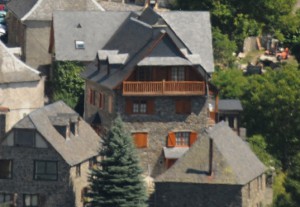
In the village of Arròs one finds the historical archives of the Aran Valley, containing material dating back to the 16th century. Its church is unique in the Aran Valley because it features an octagonal tower belfry with an almost flat roof, and is in the Gothic style, though subsequently refurbished. From this village, located at 956 m, one can access the largest waterfall in the Aran Valley: the Saut deth Pish.
Arró
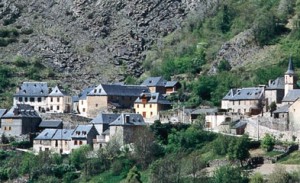
inhabitants. This small village of the Terçon de Larissa district is located at 908 m, and its main attraction is its parish church dedicated to Sant Martí. This church consists of a single nave covered with a continuous barrel vault, interrupted by a single perpend. The presbytery is framed by a triumphal, Roman-style arch, noticeably squared and covered by an arched vault. Two facing chapels, one on each side of the nave, furnish the building with the shape of a Latin cross.
From Arró one can take several excursions through enchanting forests to the surrounding towns, like Arres, Vilamos and Begós.
Arres de Sus and Arres de Jos
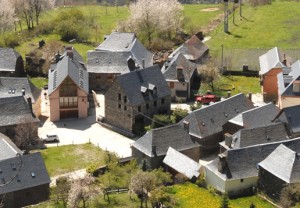
Arres de Sus, the highest, and Arres de Jos, below, are two of the most charming towns in the Aran Valley, located on the slopes of Mt. Ushèra, just 2 km from the town of Vilamós. From both towns there are easy hikes to the Forest of Aiguedau, or one can enjoy one of the most beautiful panoramic views of the Aran Valley from the small lake of the Balsa de Arres. The main feature characterising these places is how they are separated by a modern parish church dedicated to Sant Feliu.
Benós and Begós
Benós and Begós are located at 895 and 985 m, respectively, and form part of the Terçon de Larissa district. In Begós we find the Romanesque Iglesia de Sant Roc, and in Benós the Iglesia de Sant Martí. These villages preserve their authenticity thanks to their steep little streets and houses of stone and wood, seamlessly blending into the Aran Valley's alpine landscape.
Betlan
Betlan sits at 1,041 m. It is a small town with a church dedicated to Sant Pèir, dating from the 11th century. Of special note is its square bell tower and well-conserved, centuries-old apse. Betlan is also known for its legend of the giant Mandronius.
Betren
Betren is located right on the road and next to the Aranese capital, at an elevation of 1,036 m. Here we find one of the loveliest churches in the Aran Valley: the parish church dedicated to Sant Estèue is a chapel dating from the 12th century, with refurbishments to expand it from the 15th. It features a rectangular nave, a Gothic entrance with four arches, and columns adorned with 60 figurines in high relief.
Es Bòrdes
Es Bòrdes lies at the bottom of the valley, by the Garonne River as it passes through the Baish Aran nature reserve. Located at an elevation of 852 m, Es Bòrdes is surrounded by the River Joeu, whose cold waters run down from one of the most special places in the Aran Valley: the Uelhs deth Joeu waterfall.
The Era Mair de Diu deth Roser church, from the 19th century, features a curious slab depicting a praying knight. Es Bordes is a good starting point for several excursions in the Aran Valley, like the trail to the Artiga de Lin (meadow), or to walk El Camin Reiau.
Bossòst
Bossòst is one of the most important tourism centres in Aranese territory. Located at 710 m and divided by the Garonne River, Bossòst is a town rich in history. In this municipality we find the Iglesia dera Mair de Diu dera Purificacion, of Romanesque origin and built in the 12th century. This church constitutes a harmonious construction, featuring a rectangular layout, with three naves and three apses decorated with arcuations and Lombard bands. In the upper part of the town we find the ruins of an old castle, and various hermitages scattered across the mountain, each with its own history.
Casarilh
Casarilh, in Naut Aran, is located at 1,050 m above sea level. Its centre is perfect for wandering to gaze at its old houses and their Renaissance touches. Its church, which has been renovated several times, has a facade which dates back to 1731 and is a must-visit, for its lintel with an anagram of Christ over the door.
Canejan
The village of Canejan is located at an elevation of 960 m, looking down upon the Toran River valley. It is comprised of a cluster of houses, and several narrow and sloping streets. These houses include some notable residences: the Saurat House, with its defence tower dating from the 16th century; and the Benosa House, featuring a Romanesque chapel with a bell gable. Its parish church is dedicated to Sant Joan d'Agost and exhibits modern architecture, dating from 1818 and consisting of a single nave and a square bell tower.
Garòs
Garòs is one of the towns that has seen the most growth over the years. Its Romanesque church, dating from the 14th-15th centuries, has a single nave, a Baroque altar from 1774, side chapels, a square bell tower with side windows, and an adjacent cemetery. There is an interesting large Aranese house in the Pleta de Garòs, which was awarded a Medal of Tourism Merit.
Gausac
In the town of Gausac, located at 994 m above sea level, we find the parish church dedicated to Sant Martí. It is one of the largest examples of Gothic architecture in the Aran Valley. This building presents a rectangular layout with a single nave. There is a small portico on the large door featuring elements dating from various periods. A robust, octagonal 15th-century bell tower stands over the entrance. Inside is a Gothic altar divided into 8 pieces. On one of the walls we find an embossed Christ image, and in the rectory, a white marble stele measuring 52 x 44 cm. From Gausac one can take the route to the Baricauba Forest and the Bassa d'Oles (lake).
Gessa
Gessa is located at 1,232 m, situated between Arties and Salardú. It is a small town with very picturesque landscapes and surrounded by green meadows. The parish church dedicated to Sant Pere is modern in its construction, with three lateral chapels on both sides, and a Baroque altar. Of note is the Casa Rosa, a 16th-century building featuring a Gallo-Roman memorial stone ("Lpom Paulinianvs V.S.L.M."); and the Casa de Xelina, from 1575, with a Catalonian coat-of-arms; the Casa Pont, from 1589; and the Casa Fradera Pont, from 1618. From Gessa there is an interesting two-hour walk to the Ermita (hermitage) de Sant Martí along a bridle path.
Les
Les is another of the important tourism centres in the Aran Valley. It is located at an elevation of 631 m. At the end of this Aranese village we can visit the ruins of the old castle of the Barones de Les. Here we also find a chapel, La Capilla de Sant Blai, with a circular layout; and the Hot Springs of Les, dating from 1852, characterised by their sulphur-sodium waters, at a temperature 35º, recommended for the treatment of rheumatism and other diseases of the skin and/or bones.
Mont and Montcorbau
Mont and Montcorbau sit at elevations of 1,235 m and 1,222 m, respectively. Both towns offer some of the best views of Vielha and the Baricauba Forest. In Montcobau of note is the parish church dedicated to Sant Esteve, with Romanesque elements inside. The bell tower's design is square and has an anagram of Christ on its entranceway, as well as a papal tiara. In Mont is the parish church of Sant Laurenç, which is modern in style, as from the Romanesque era only an entranceway and baptismal font remain. Its nave features a barrel vault, and its bell tower presents a square design.
Montgarri
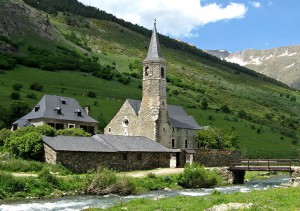
El Santuari de Montgarri is one of the most historic sites in the Aran Valley. This Pyrenean village is located at an elevation of 1,645 m, along the Noguera Pallaresa River. The origin of this sanctuary dates back to 1117-119, when, according to the tradition, they found the Virgin Mary here. The sanctuary consists of several structures forming a square layout. High above is an octagonal bell tower, with windows in its upper section. It is a Renaissance construction that once consisted of a hostel, church, rectory and administrative offices, in addition to several corrals with hay lofts. Today it serves as an ideal destination for a family excursion.
Salardú
Salardú is located at an elevation of 1,268 m. Its sloping streets and traditional corners feature fountains and watering troughs for livestock. It has a spacious square and ruins of the old Portal de Pallars, from the 13th century, and the walls from that era, when it boasted a castle, with walls and towers.
In some houses you can still find windows dating back to the 17th century. The parish church is dedicated to Sant Andreu, and contains an image from the 12th century. The building is from the era that saw the transition from Romanesque to Gothic architecture (12th -13th centuries). It is a rectangular building with three naves, a triple apse, Gothic window and a Romanesque door. The bell tower is octagonal, with two floors (15th century). It has a Baroque altar and the famous Sant Crist de Salardú, from the 12th century. It constitutes one of the most remarkable Romanesque churches in the Aran Valley.
Tredos
We recommend visiting the Romanesque church of Santa María de Cap d'Aran. It is a unique church with a crypt and a tower separate from the building. It was formerly an old Templar convent that was highly influential in the 13th and 14th centuries. Thanks to this distinction the town of Tredòs was granted an exemption from the Galín Reiau, the only tax the Aranese were obliged to pay. The town of Tredos, at an elevation of 1,740 m, is a good starting point for excursions recommended for both families and groups of friends.
Unha
The village of Unha is located at 325 m, on a mound and at the foot of the imposing and precipitous Pui d 'Unha, which offers splendid views of the entire valley, including the glaciers and peaks of La Maladeta. The town boasts a parish church dedicated to Santa Eulària, in the Romanesque style and dating from the 12th century. Inside the church we find a monogram of Christ on the lintel, three interior naves, an octagonal bell tower, and a pointed roof. In addition to strolling its streets, a good option in Unha is to visit its Snow Museum.
Vila
The village of Vila is located at an elevation of 1,096 m, above the villages of Aubert and Arròs. This village features a typical set of stone houses and a spectacular panoramic view of the Baricauba Forest, Montcurbisson Mountain, and the summits of Entecada. These spectacular views are in addition to the parish church dedicated to Sant Roc, varied in its architectural style, and with a square tower bell tower.
Vilac
The town of Vilac is located at an elevation of 1,047 m, along the banks of the Garonne River and ensconced in the Salient Valley, from which the Salient River flows.
Vilac has a special charm thanks to its well-maintained streets, urban slopes and hidden squares. There are still old houses here with lintels dating from 1700. The church square is a nice site from which to admire the landscape of Vielha, with the nearby mountains of Sarrahèra and banks of the Nere River.
Of special note is parish church of Sant Felix; Romanesque in style, dating from the 12th and 13th centuries. The church has three naves, a transept featuring modern architecture, and remarkable Romanesque architectural elements that contrast with the pulpit's Gothic carving. The bell tower is square, with Gothic windows on its sides and on the two floors. The door presents four vaulted arches featuring columns and capitals with small heads carved on them, and in the tympanum we find a figure of the Redeemer. Without any doubt, a must-see in the Aran Valley.
Vilamòs
Vilamòs is located at an elevation of 1,255 m and considered one of the oldest villages in the Aran Valley. It sits on a plateau on Mount Ushèra, on the Montlude face, offering a spectacular view over the Artiga de Lin, Mall de la Artiga and the Maladeta massif, with its Aneto Peak. Of particular note is its chapel, the Capilla de San Miquèu, dating from the 11th century, said to be the oldest church in the entire valley.
Here we also find the parish church of Sta. Maria, built between the 11th and 12th centuries. The presbytery is covered by three sections featuring groin vaulting and a font from the 12th century, decorated with fleur-de-lis and supported by a pedestal in white marble adorned with diamond tips. On the outer walls of the belfry we find a Roman star with three busts, probably depicting the members of a patrician family, and two burial urns.
We can highlight the Museo Etnológico de Joanchiquet, an “ecomuseum” created to disseminate the Aranese cultural heritage and, more specifically, the family and economic organisation of an affluent household between the 18th century and the second half of the 20th. In each visit visitors are transported to this rural world by the guides’ descriptions and the atmosphere created by the traditional furniture of this corner of the Pyrenees, from the 18th, 19th and 20th centuries.
Baguerge
Bagergue is one of the most beautiful and authentic villages in the Aran Valley. It sits at an elevation of 1,490 m, and represents the highest inhabited town in the Valle d'Aran. Here we find the Museo Eth Corrau, which houses more than 2,500 pieces of Aranese rustic crafts.
Here one can also visit the parish church of Sant Feliu, dating from the 12th century, later remodelled in the 16th. From Bagergue one can also set out on several excursions perfect for nature lovers.
Casau
Presided over by the Montcorbisson, Casau enjoys an exceptional location, offering the best panoramic views of Vielha, including the Aran Valley. Of particular note is its church dedicated to Sant Andreu, a fine example of the confluence of several architectural styles.
 Alpine meadows surrounded by mountains
Alpine meadows surrounded by mountains 300+ lakes to explore
300+ lakes to explore Neverending valleys
Neverending valleys Traditional Aranese Dances
Traditional Aranese Dances Romanic Art all throughout the Valley of Aran
Romanic Art all throughout the Valley of Aran Era Hèsta deth Haro, an Aranese particularity
Era Hèsta deth Haro, an Aranese particularity









